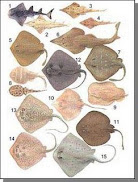Nose rigging is a quick way to rig any baitfish for trolling or as a drop back bait. It is particularly well suited to using with circle hooks as it ensures that the hook point is not masked by the bait, and the short trolling 'bridle' allows the bait to be easily turned for swallowing.
You will need a rigging needle (mortician's needles are best) and a length of old Dacron or waxed cotton or linen thread. Dacron works great for me.
For a smallish baitfish such as an Atlantic mackerel or a Mullet use a 4 inch needle and around 20 inches of thread. Scale up to a 6 inch needle and around 30 inches of thread when using something like a Bonito or Skipjack tuna. Secure the thread to the needle with a single half hitch to stop it pulling out of the needle eye.

1) Take the baitfish and insert the needle into the gill cover approximately 1/3 way up from the throat latch at the bottom. Pass the needle right through and exit the opposite gill cover in a similar position.
Pull the Dacron almost all the way through and tie off under the chin using a Surgeons knot. The gill covers are now tied closed.

Trim off the tag end only.
2) Insert the needle up through the lower jaw and out of the RIGHT nostril. Pull to take up any slack. The Dacron from the gill covers will lay neatly in the groove beneath the jaw.
Come around and again pass the needle up through the lower jaw and out of the RIGHT nostril using the same path that you used the first time. Pull tight to close the right side of the mouth.

3) Now it becomes a little (but only a little) more tricky. Insert the needle up through the right side of the lower jaw and out of the LEFT nostril.
Before pulling through the slack Dacron put your index finger against the mouth of the baitfish and take up the slack around your finger. You are forming a towing loop the size of your finger. Again pass the needle up through the same hole in the lower jaw and again out through the left nostril.
Pull tight and the left side of the mouth is now stitched shut.

4) Pass the Dacron around your finger a second time and insert the needle up through the centre of the jaw and out of the upper jaw between the nostrils.
Pull tight and you will now have two towing loops around your finger.

5) Remove your finger from inside the trolling loops and finish with several half hitches around both loops to make things secure.
Baits prepared in this way can be stored in a cooler until required with no chance of tangling.

To attach to a hook, pass the hook point through the two loops, wrap the loops around the hook point once and pass the point through the loops again. The bait should hang about an inch from the bend of the hook.

 NOT LEGAL as back hook is not firmly imbedded in or securely attached to the bait, and is a dangling or swinging hook.
NOT LEGAL as back hook is not firmly imbedded in or securely attached to the bait, and is a dangling or swinging hook. LEGAL as both hooks are firmly imbedded or securely attached to the bait. Would not be legal if eyes of hooks were more than 18 inches (45.72 cm) apart
LEGAL as both hooks are firmly imbedded or securely attached to the bait. Would not be legal if eyes of hooks were more than 18 inches (45.72 cm) apart



























